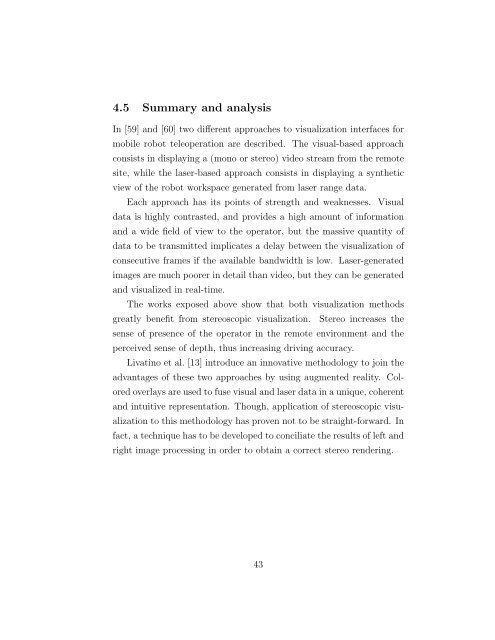Scarica (PDF – 6.19 MB)
Scarica (PDF – 6.19 MB)
Scarica (PDF – 6.19 MB)
You also want an ePaper? Increase the reach of your titles
YUMPU automatically turns print PDFs into web optimized ePapers that Google loves.
4.5 Summary and analysis<br />
In [59] and [60] two different approaches to visualization interfaces for<br />
mobile robot teleoperation are described. The visual-based approach<br />
consists in displaying a (mono or stereo) video stream from the remote<br />
site, while the laser-based approach consists in displaying a synthetic<br />
view of the robot workspace generated from laser range data.<br />
Each approach has its points of strength and weaknesses. Visual<br />
data is highly contrasted, and provides a high amount of information<br />
and a wide field of view to the operator, but the massive quantity of<br />
data to be transmitted implicates a delay between the visualization of<br />
consecutive frames if the available bandwidth is low. Laser-generated<br />
images are much poorer in detail than video, but they can be generated<br />
and visualized in real-time.<br />
The works exposed above show that both visualization methods<br />
greatly benefit from stereoscopic visualization. Stereo increases the<br />
sense of presence of the operator in the remote environment and the<br />
perceived sense of depth, thus increasing driving accuracy.<br />
Livatino et al. [13] introduce an innovative methodology to join the<br />
advantages of these two approaches by using augmented reality. Col-<br />
ored overlays are used to fuse visual and laser data in a unique, coherent<br />
and intuitive representation. Though, application of stereoscopic visu-<br />
alization to this methodology has proven not to be straight-forward. In<br />
fact, a technique has to be developed to conciliate the results of left and<br />
right image processing in order to obtain a correct stereo rendering.<br />
43




